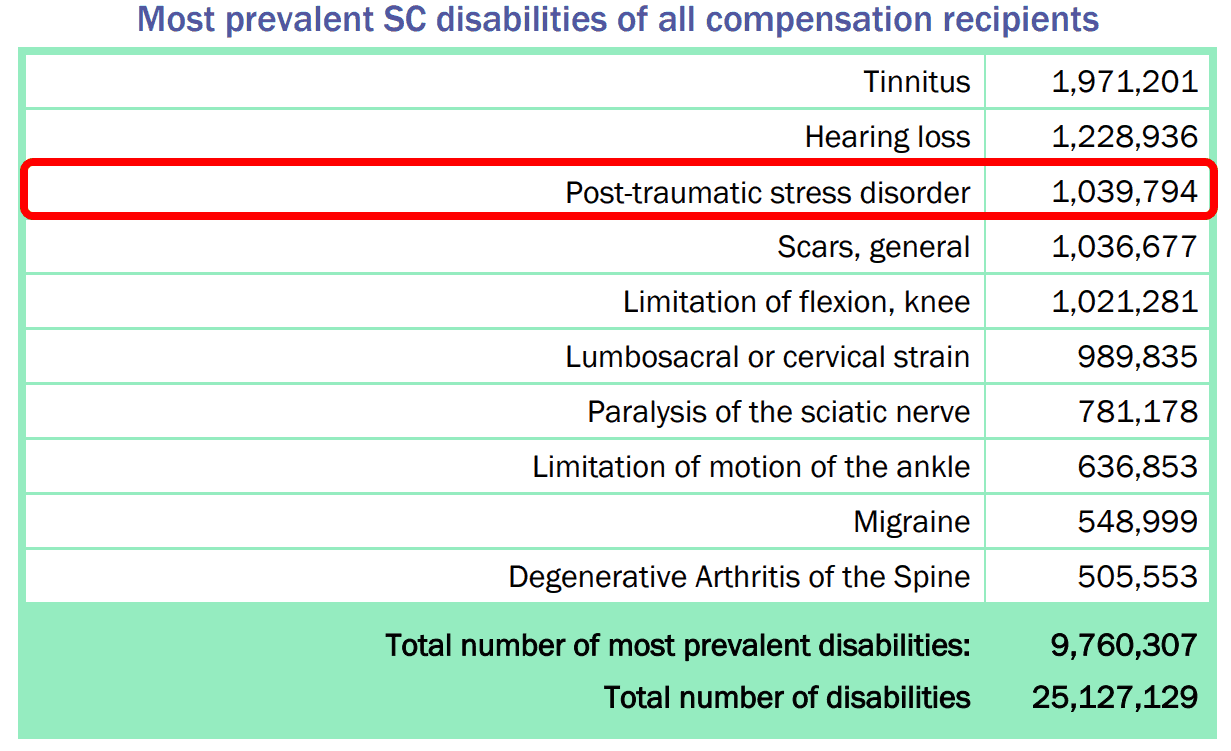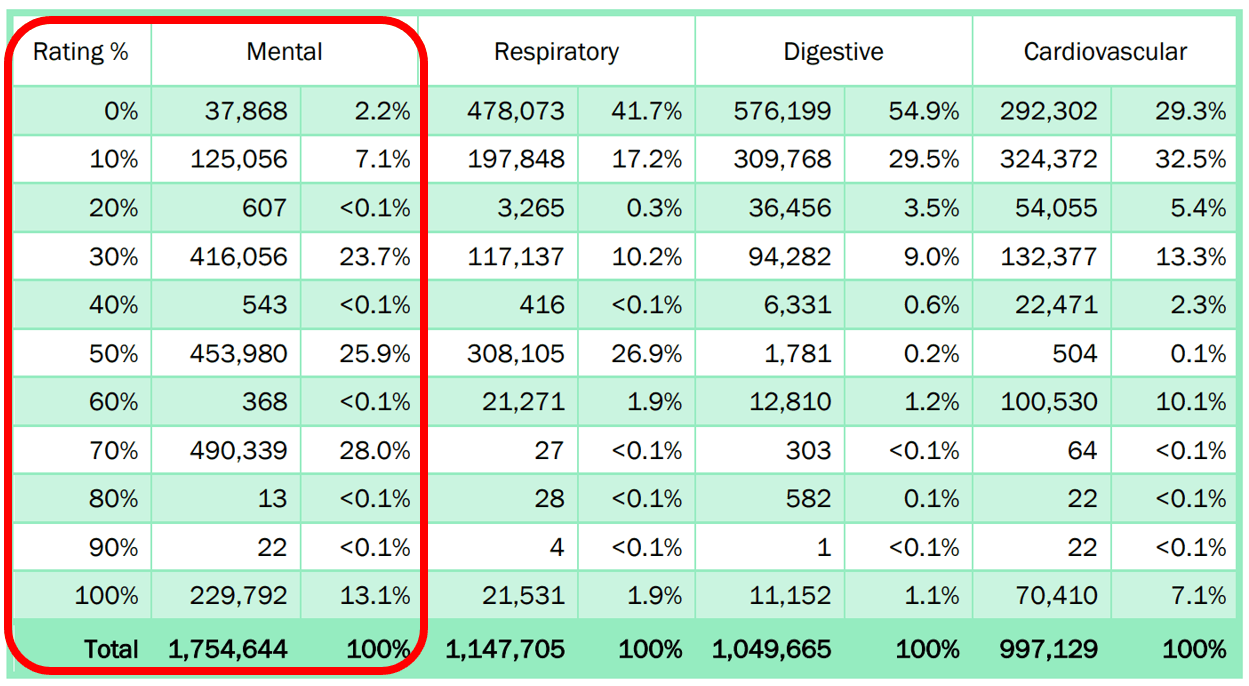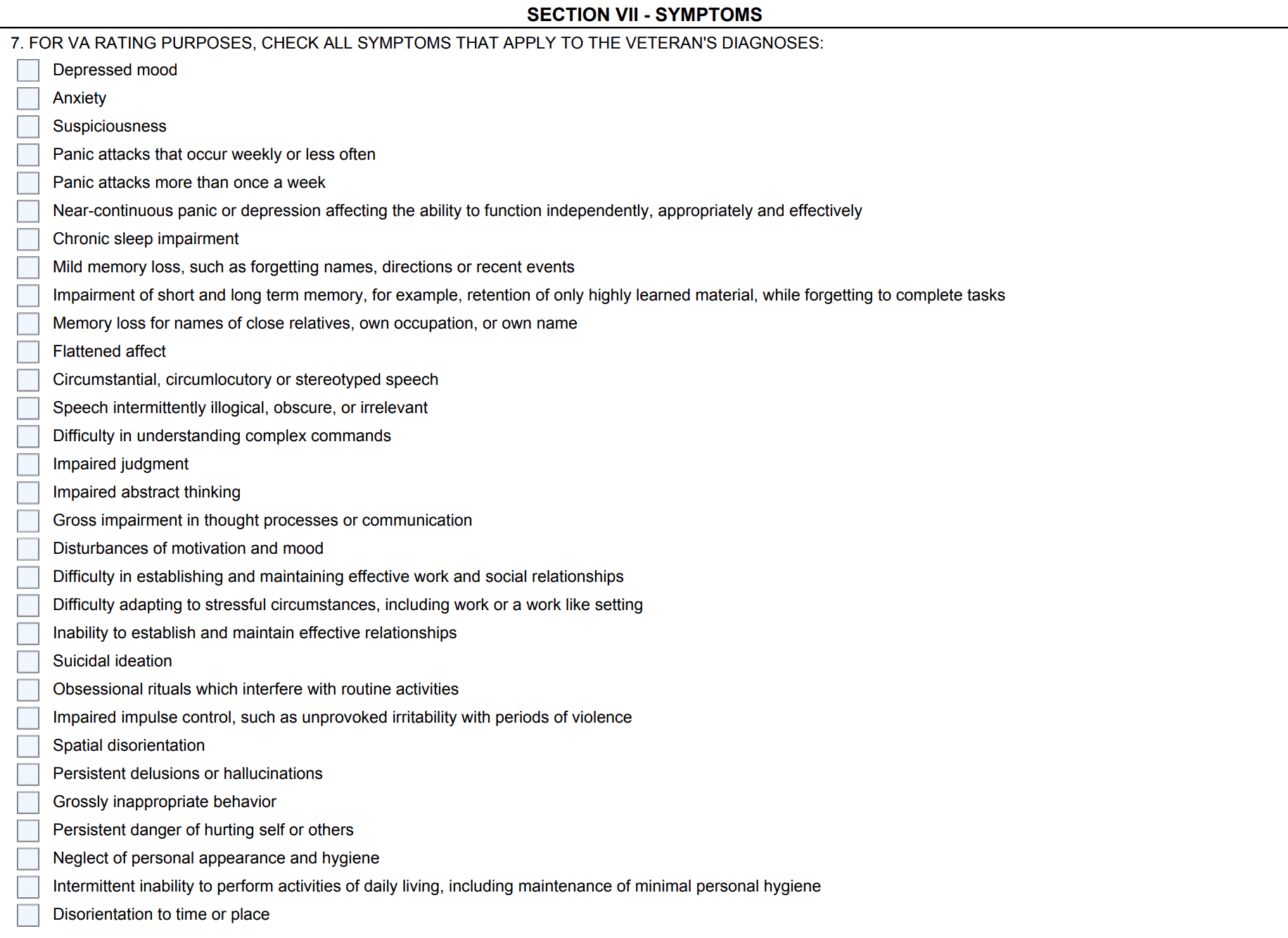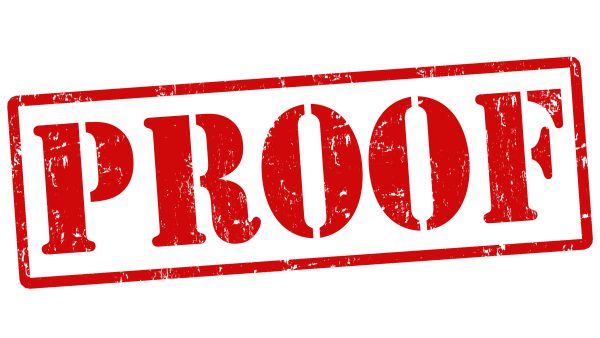Looking for Expert-Level VA Claim Answers?📱Call Us Now! 737-295-2226
In this post, we will cover my Top 5 Tips to Increase Your VA Disability Rating for PTSD (even if you’ve already filed or been denied).
Your final VA disability rating for PTSD depends upon the severity of your mental health symptoms as well as your current level of occupational and social impairment.
Generally, the more severe your symptoms, the higher the VA rating you’ll receive for PTSD.
- VA Rating for PTSD – Basic Eligibility Criteria
- PTSD is the #3 Easiest VA Claim to Win
- List of Average VA Disability Ratings for PTSD
- VA Disability Rating for PTSD from 0% to 100%
- Most Important Sections of the PTSD DBQ
- VA PTSD Ratings – Frequently Asked Questions
- Can I get VA disability compensation for PTSD?
- Is PTSD considered a VA disability?
- What are the VA disability ratings for PTSD?
- How much does the VA pay for PTSD?
- Can I receive Special Monthly Compensation for PTSD?
- Can PTSD be permanent and total?
- Can the VA reduce my disability rating for PTSD?
- How do I get a 100% VA disability for PTSD?
- Can I work with a 100% PTSD rating?
- Will PTSD affect my security clearance?
- Is PTSD only related to military combat?
- What is a PTSD stressor?
- WATCH: How to Prepare for Your C&P Exam for PTSD
- About the Author

TIP #1: If you’re trying to increase your VA rating for PTSD because you believe your symptoms warrant the higher rating under the law, you’ll need to provide medical evidence to show how your symptoms have worsened.
One you have medical evidence from a private provider and/or the VA, you simply file for an increase on your PTSD inside your VA.gov account.
The VA Rater, also known as the RVSR, will make this subjective rating assessment by comparing all your supporting evidence submitted with your claim along with the C&P examiners notes on the electronic version of the Disability Benefit Questionnaire (DBQ) for PTSD.
The VA Ratings for PTSD are: 0%, 10%, 30%, 50%, 70%, and 100%. The average VA disability rating for PTSD is 70% across all Veteran Demographics.
VA Rating for PTSD – Basic Eligibility Criteria
In order to be eligible for a VA disability rating for PTSD, a veteran must meet three criteria by law:
#1. Medical diagnosis of PTSD or Other Mental Health Condition (e.g., Major Depressive Disorder)
#2. Your PTSD was caused or made worse by your active duty military service (“Nexus”)
#3. Persistent and reoccurring symptoms of PTSD or other mental health condition(s) into the present day (severity of symptoms)
If you think you have PTSD, but don’t have a medical diagnosis, pick-up the phone and call the VA mental health facility nearest you to make an appointment.
TIP #2: >> Did you know PTSD always has stressors? Click HERE to learn more. <<
PTSD is the #3 Easiest VA Claim to Win
According to the Veteran Benefits Administration’s (VBA) report to congress, VA disability claims for PTSD are among the easiest VA claims to win, and are the #3 most compensated claim overall behind Tinnitus and Hearing Loss.

Presently, 1,039,794 veterans out of 4,743,108 VA compensation recipients have a VA rating for PTSD.
Thus, 21.9% of all disabled veterans receiving disability compensation from the VA have a service-connected rating for PTSD of 0% or higher.
59.3% of all veterans with a VA mental health rating are rated for Post Traumatic Stress Disorder.

List of Average VA Disability Ratings for PTSD
- 37,868 veterans or (2.2%) of all VA disability compensation recipients for PTSD have a 0% rating.
- 125,056 veterans or (7.1%) of all VA disability compensation claim recipients for PTSD have a 10% rating.
- 416,056 veterans or (23.7%) of all VA compensation claim recipients for PTSD have a 30% PTSD rating.
- 453,980 or (25.9%) of all VA disability recipients for PTSD have an automatic 50% PTSD rating.
- 490,339 or (28.0%) of all VA claim recipients for PTSD have a 70% PTSD rating.
- 229,792 or (13.1%) of all VA disability claim recipients have a 100% PTSD rating.

The overall average VA disability rating for PTSD is between 50% and 70%, which makes it a high-value VA claim.
The median and mode PTSD rating for all veterans in 2020 was 70%.
VA Disability Rating for PTSD from 0% to 100%
0% PTSD Rating Criteria
A mental condition has been formally diagnosed, but symptoms are not severe enough either to interfere with occupational and social functioning or to require continuous medication.
This means you have a PTSD diagnosis, but no subjective symptoms.
You have no occupational and social impairment at the 0% PTSD rating level.
>> Click HERE to see the entire PTSD Rating Scale in detail
Symptoms of 10% PTSD Rating
Occupational and social impairment due to mild or transient symptoms which decrease work efficiency and ability to perform occupational tasks only during periods of significant stress, or symptoms controlled by continuous medication.
Translation: You have very mild symptoms of PTSD.
Maybe you take antidepressants, but these medications keep your symptoms in check.
30% PTSD VA Rating Symptoms
Occupational and social impairment with occasional decrease in work efficiency and intermittent periods of inability to perform occupational tasks (although generally functioning satisfactorily, with routine behavior, self-care, and conversation normal), due to such symptoms as: depressed mood, anxiety, suspiciousness, panic attacks (weekly or less often), chronic sleep impairment, mild memory loss (such as forgetting names, directions, recent events).
The 30% rating for PTSD still has fairly mild symptoms. You have some depression, anxiety, memory loss, and panic attacks, but not very often. You might be having some trouble sleeping along with mild memory loss.
Typically, you’re having panic attacks LESS than once per week.
50 Percent VA Disability Rating for PTSD
Occupational and social impairment with reduced reliability and productivity due to such symptoms as: flattened affect; circumstantial, circumlocutory, or stereotyped speech; panic attacks more than once a week; difficulty in understanding complex commands; impairment of short- and long-term memory (e.g., retention of only highly learned material, forgetting to complete tasks); impaired judgment; impaired abstract thinking; disturbances of motivation and mood; difficulty in establishing and maintaining effective work and social relationships.
The 50% rating for PTSD has moderately severe symptoms.
The biggest difference between the 30% and 50% rating is that at this level, you’re having a lot of trouble in your relationships. Perhaps you don’t have any friends or just want to be alone. Maybe you’re divorced or can’t get along with your spouse anymore.
The other difference is you’re now having panic attacks MORE than one time per week.
Symptoms of the 70% Rating for PTSD
Occupational and social impairment, with deficiencies in most areas, such as work, school, family relations, judgment, thinking, or mood, due to such symptoms as: suicidal ideation; obsessional rituals which interfere with routine activities; speech intermittently illogical, obscure, or irrelevant; near-continuous panic or depression affecting the ability to function independently, appropriately and effectively; impaired impulse control (such as unprovoked irritability with periods of violence); spatial disorientation; neglect of personal appearance and hygiene; difficulty in adapting to stressful circumstances (including work or a work like setting); inability to establish and maintain effective relationships.
The 70% PTSD rating has very severe symptoms and is a big jump from the 50% level.
Notice the keyword change to “deficiencies in most areas.”
Maybe you constantly check windows and doors in your home or have other obsessive rituals as you go about your day, such as a video camera monitoring system around your property.
Your panic attacks, depression, and anxiety are now happening constantly. You think about suicide often, meaning you’re having thoughts or even making plans. You are unable to establish and maintain effective relationships at work and socially.
100% VA Rating for PTSD Criteria
Total occupational and social impairment, due to such symptoms as: gross impairment in thought processes or communication; persistent delusions or hallucinations; grossly inappropriate behavior; persistent danger of hurting self or others; intermittent inability to perform activities of daily living (including maintenance of minimal personal hygiene); disorientation to time or place; memory loss for names of close relatives, own occupation, or own name.
The 100% PTSD rating has the most severe symptoms.
Notice the change to “total occupational and social impairment.” This means you’re having major issues at work and at home.
Perhaps you can’t work because your PTSD is so severe. This is the first time we see delusional thoughts, hallucinations, and grossly inappropriate behavior.
Severe memory loss and occasional inability to care for oneself are now present at the 100% level.
Most Important Sections of the PTSD DBQ
You can either obtain a DBQ for PTSD from a private provider or wait and let the C&P examiner complete an electronic version of the DBQ at your compensation and pension exam for PTSD.
Need a PTSD DBQ? Join VA Claims Insider Elite now to get one from our private medical providers.
In addition to having a medical diagnosis for PTSD, there are two critical sections of the PTSD DBQ that determine your final VA rating for mental health.
In Section 4, a private provider or the C&P examiner will check one of 7 boxes based upon their subjective assessment of your overall level of occupational and social impairment.
You’ll notice the keywords for each block mirrors the PTSD Rating Scale verbatim.
This is the MOST IMPORTANT section on your PTSD DBQ:

Section 7 is the second most important part of your PTSD DBQ.
The reason is because your current PTSD symptoms serves as a signal to the VA Rater on the severity of your mental health condition, which ultimately affects your final rating.
The more severe your PTSD symptoms are, the higher the VA rating you’ll receive:

VA PTSD Ratings – Frequently Asked Questions
Can I get VA disability compensation for PTSD?
Yes. The Department of Veterans Affairs will pay veterans with service-connected PTSD tax free compensation each month. The amount of compensation depends upon your overall VA rating.
Is PTSD considered a VA disability?
The Department of Veterans Affairs recognizes PTSD as one of 31 mental health conditions that may be related to service, and thus, PTSD is a VA disability, and is eligible for VA compensation and benefits under the law.
What are the VA disability ratings for PTSD?
The VA will give you a disability rating based upon the severity of your PTSD, specifically related to your level of occupational and social impairment. If you are considered service-connected for PTSD, you will receive one of six possible VA disability ratings, broken out as follows: 0%, 10%, 30%, 50%, 70%, or 100%.
How much does the VA pay for PTSD?
If your PTSD claim is approved, you may receive up to $3,421.90 per month. That is currently the max that the VA will pay veterans with PTSD and includes SMC for PTSD housebound, if at the 100% rating criteria for PTSD. If you’re rated at 100% for PTSD, you’re eligible to receive an additional $364.77 per month for SMC housebound.
Can I receive Special Monthly Compensation for PTSD?
Yes! VA Special Monthly Compensation under Category S is given if the veteran has at least one condition rated 100% AND one or both of the following:
#1. You are completely and permanently housebound because of his service-connected conditions, meaning that the veteran cannot leave his area of abode (this can include his own home, a hospital ward, or a care facility) at all, and this is expected to be the case for the rest of his life OR
#2. You have another condition rated 60% or group of conditions together rated 60% that are unrelated to the 100% condition. For example, you have GERD rated at 60% and PTSD rated at 100%.
Veterans can get an extra $364.77 each month, tax-free, if you meet the PTSD housebound criteria.
Can PTSD be permanent and total?
Some veterans may receive a permanent and total rating, also known as 100% P&T. If your PTSD is not expected to improve, you may obtain the status of permanent and total disability. Did you know VA Claims Insider has medical doctors who may be able to write a “Permanent and Total” letter for you to help you get a 100% P&T VA rating?
Can the VA reduce my disability rating for PTSD?
Yes. Unfortunately, sometimes the VA will lower a veteran’s PTSD rating. If that happens to you, obtain new and relevant medical evidence for PTSD and challenge the VA’s decision to lower your rating.
How do I get a 100% VA disability for PTSD?
Your PTSD must be severe enough to warrant a 100% rating. Many veterans do obtain a 100% rating for PTSD using VA Claims Insider’s proven proprietary medical consulting process for DBQ Reviews and credible Medical Nexus Letters.
Can I work with a 100% PTSD rating?
Yes you can! It is a myth that having PTSD somehow means you can’t work. In fact, you can work with any PTSD rating. Even if you’re rated at 100% for PTSD, there is no requirement or mandate that affects your work.
Will PTSD affect my security clearance?
It is a myth that having PTSD or a PTSD rating will somehow affect your security clearance. Of course you’ll need to report it to your security manager and update your SF 86; however, it has no impact on your security clearance (in our experience serving 5,000+ veterans with PTSD since 2016).
Is PTSD only related to military combat?
No! For VA rating purposes, PTSD claims can be either PTSD combat or PTSD non-combat, such as MST PTSD. Each category has its own special criteria. Click HERE to read more about the two types of PTSD VA claims.
What is a PTSD stressor?
Many veterans who experience a traumatic event on active duty develop PTSD. This traumatic event is often referred to as a “PTSD stressor” by the VA. The VA states a stressor involves exposure to death, threatened death, actual or threatened serious injury, or actual or threatened sexual violence. Click HERE to read about PTSD Non Combat Stressors.
WATCH: How to Prepare for Your C&P Exam for PTSD
The C&P Exam for PTSD is the #1 MOST IMPORTANT day in the 8 step VA claim process and arguably makes or breaks your final mental health rating. You must be prepared to talk about your mental health symptoms in detail and tell the C&P examiner how your PTSD is affecting your work, life, and social functioning. Click HERE for My Top 5 C&P Exam for PTSD tips!
About the Author

Brian Reese
Brian Reese is a world-renowned VA disability benefits expert and the #1 bestselling author of VA Claim Secrets and You Deserve It. Motivated by his own frustration with the VA claim process, Brian founded VA Claims Insider to help disabled veterans secure their VA disability compensation faster, regardless of their past struggles with the VA. Since 2013, he has positively impacted the lives of over 10 million military, veterans, and their families.
A former active-duty Air Force officer, Brian has extensive experience leading diverse teams in challenging international environments, including a combat tour in Afghanistan in 2011 supporting Operation ENDURING FREEDOM.
Brian is a Distinguished Graduate of Management from the United States Air Force Academy and earned his MBA from Oklahoma State University’s Spears School of Business, where he was a National Honor Scholar, ranking in the top 1% of his class.



